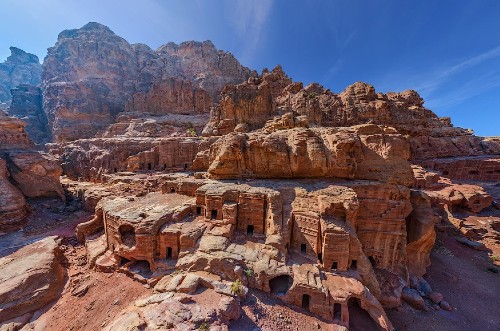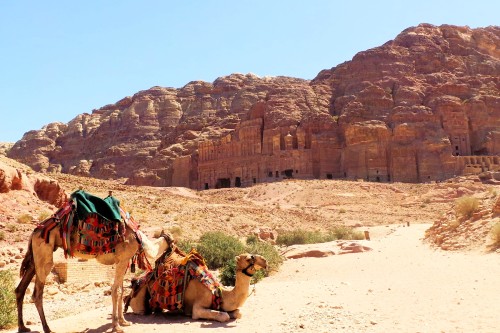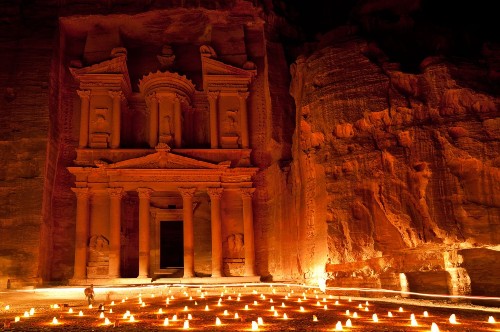The Chonnam Tribune provides an international student’s hometown story to promote mutual understanding between international and Korean students from the 353rd issue in March 2019. This page has reported the following countries: Uzbekistan, East Timor, Finland, France, Germany, Australia, Ecuador, Pakistan, Spain, and Bangladesh. – Ed.

Because it is rare to find an Arab or Jordanian student here in Gwangju, I am seizing the chance to proudly introduce one of the Seven Wonders of the World and one of most popular tourist sites in the Middle East, located in my beloved country, Jordan.
2,000-year-old Ruins in Jordan
Jordan is by far one of the Levantine region’s most celebrated destinations. It all started when the rose-city of Petra became one of the new Seven Wonders of the World back in 2007.
Petra is located about 150 miles south of Amman, the capital of Jordan, and Jerusalem the capital of Palestine and it is about midway between Damascus, Syria, and the Red Sea, making it ideally suited as a hub of commerce in the area. The city is also has running through it, from east to west, the Wadi Musa (the Valley of Moses), one of the places where, according to history, prophet Musa struck a rock and water gushed forth. The site is considered significant by historians and archeologists alike because of its beautiful rock-cut architecture and innovative water management system, the latter of which made the region inhabitable, given that it is surrounded by desert and rugged, mountainous terrain.
Petra is half built, half carved in stone. The awe-inspiring monuments of Petra are cut into cobblestone cliffs and mountains, which show a whole spectrum of colors when the sun rises and sets. Famous during the thriving age of the Nabateans rule, Petra is an ancient city that lies in present-day Jordan and it has been inhabited from as early as 7000 BC, and the Nabataeans might have settled in what would become the capital city of their kingdom, as early as the 4th century BC. The Nabataean Kingdom became a client state of the Roman Empire in the first century BC, and it was only in 106 AD that it lost its independence. After it was annexed by the Roman Empire, Nabataea was renamed “Arabia Petraea,” meaning “Arabian province”.
Petra has also been referred to as the “Rose City” because of the color of the stones used in its buildings. It was named a UNESCO World Heritage Site in 1985. The city of Petra was established as a trading post by the Nabateans, an Arab Bedouin tribe indigenous to the region in what is now southwestern Jordan. They continued to rule over the city for more than 250 years until the middle of the fourth century AD.

Must-See Attractions in Petra
The Treasury (Al-Khazneh) is one of the most elaborate temples in Petra, a city of the Nabatean Kingdom inhabited by the Arabs in ancient times. As with most of the other buildings in this ancient town, including the Monastery, this structure was carved out of a sandstone rock face. Known locally as Al Khazneh, this tomb is where most visitors fall in love with Petra. The Hellenistic facade is an astonishing piece of craftsmanship. Although carved out of iron-laden sandstone to serve as a tomb for the Nabataean King Aretas III (87-62 BCE.), the Treasury derives its name from the story that an Egyptian pharaoh hid his treasure here in the facade urn. Some locals clearly believed the tale because the 3.5m-high urn is pockmarked by rifle shots. As with all rock-hewn monuments in Petra, the interior is unadorned. The Treasury is at its most photogenic in full sunlight between about 9 a.m. and 11 a.m.
The Siq, also known as Siqit, is the main entrance to the ancient Nabatean city of Petra in southern Jordan. As we can see in the name, which literally translates into “the Shaft”, it is a dim, narrow gorge and winds its way approximately 1.2 km, and ends at Petra's most elaborate ruin, Al Khazneh. A wide valley outside leading to the Siq is known as the Bab as-Siq, meaning “Gateway to the Siq.” Along the way you can admire the natural curves and the fascinating colors of the rock. The walk is quite a lot longer that one would expect, being over 1km, but every minute is a pleasure for the eyes. At that time, I could walk alone in the quiet environment and take it all in.
The Great Temple at Petra is a grand monumental complex that lies south of Colonnaded Street at Petra, covering an area of approximately 7,560 m². The complex was probably completed in the early first century CE, under the rule of Nabataean king Aretas IV (9 BCE – 40 CE), as suggested by architectural and sculptural details.
The Petra Museum, and the Exhibition of Petra visitor center contain 280 artifacts, dating back to different ages, the exhibition consists of five halls showing the history of Petra and information about the Nabatean's life and their civilization. It also shows many other historical pieces such as life tools and statues, which were discovered in Petra by archaeological excavations teams.

Petra at Night
Last but not least, visiting Petra during nighttime is awe-inspiring. To experience it at night by the light of 1,800 candles is truly out-of-this-world. Walkthrough the Siq to the Treasury, following a candle-lit path and enjoy the haunting music of the Bedouins at the Treasury, with a fresh sage tea allowing yourself plenty of time to have an amazing experience walking through rich history. You really don't want to miss this unique journey adventure!
By Fatima Alkhadire, Master’s Student, Non-Governmental Organizations

